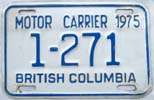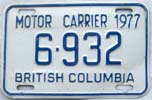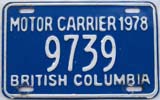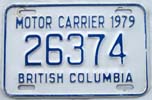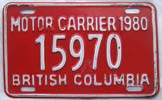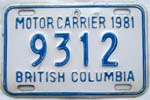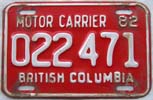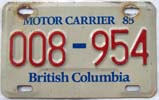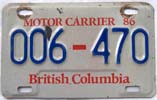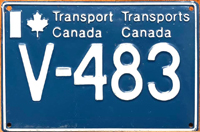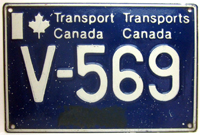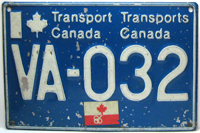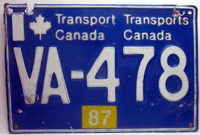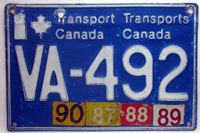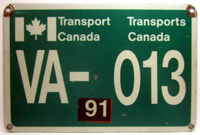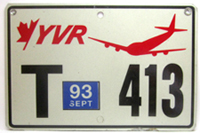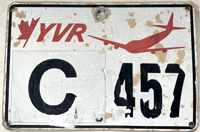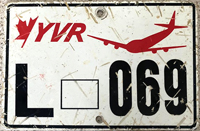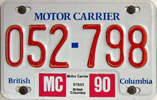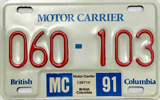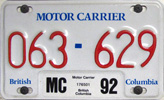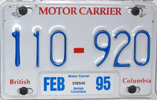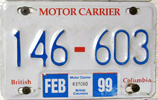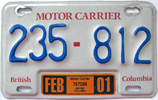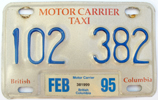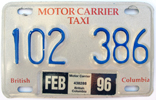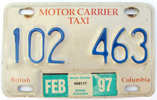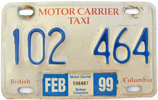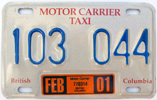|
British Columbia Motor Carrier License Plates |
||||||||||||||||||||||||||||||||||||||||||||||||||||||||||||||||||||||||||||||||||||||||||||||||||||||||||||||||||||||||||||||||||||||||||||||||||||||||||||||||||||||||||||||||||||||||||||||||||||||||||||||||||||||||||||||||||||||||||||||||||||||||||||||||||||||||||||||||||||||||||||||||||||||||||||||||||||||||||||||||||||||||||||||||||||||||||||||||||||||||||||||||||||||||||||||||||||||||||||||||||||||||||||||||||||||||||||||||||||||||||||||||||||||||||||||||||||||||||||||||||||||||||||||||||||||||||||||||||
Quick Links: |
Motor Carrier | Prefix Gallery | Classifications | Passenger Carrier |
| 1926 - 1929 | ||||||||||||
1926
|
1929 |
|
||||||||||
Readers asked to be aware that the placement of the Public Works Department ("P.W.D.") plates shown above as early issue motor carrier plates is purely speculative. There is no known evidence linking these particular plates to the possible registration of public and freight carriers between the years 1926 and 1929, however, there are some similarities that link them to later issues such as the "Special Permit" designation - but even this is tenuous. Until more information comes to light, we shall consider these to be carrier plates. |
*
* * * * |
In 1930, British Columbia took its first step towards economic regulation by amending the Highway Act, so that both public passenger and public freight-vehicle licences could be issued for vehicles operating on either a regular route or between fixed termini. It is thought that as a result of the change to Highway Act, the province - through the Public Works Department - began to issue license plates to motor carriers and that the plates shown below are examples of what would have been displayed on freight-vehicles. |
| 1930 - 1934 | ||||||||||||||||
1931 |
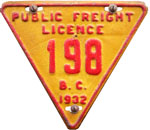 |
|
||||||||||||||
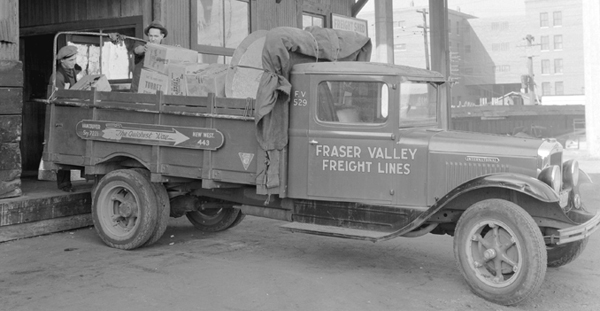 |
|
In this photo, a truck used for the hauling of freight is clearly displaying a 1934 "P.C. Licence Freight" licence plates immediately behind the passenger side door. IMAGE SOURCE: Vancouver Public Library |
Not unlike the 1927 & 1928 issues shown above, readers are again asked to be aware that the placement of the Public Works Department ("P.W.D.") and "P.C. Licence" plates shown above as early issue motor carrier plates is somewhat speculative. It is thought, however, that the references to "Stage Permit" and "Freight" clearly links these to the regulation of vehicles moving people and goods - which is consistent with the requirements of the Act. |
*
* * * * |
By the mid-1930s, the province had begun to receive numerous complaints from licensed carriers regarding encroachment on their businesses by "fly-by-night" operators. In response, Part V of the Highway Act was expanded during the 1935 session of the Legislature to include all classes of passenger and freight transportation for compensation and also private freight carriers and effectively marked the beginning of true economic regulation of the trucking industry in the province. The practical effect of this change was the introduction of eleven (11) letter prefixes - "A" through "L" - that would be used to denote the different classification of carriers under the Act. For instance, one of the more common prefixes is "K" , which allowed for "a Private Freight-vehicle owned by and operated by or on behalf of a bona-fide farmer and used exclusively for the transportation of his own agricultural, orchard or dairy products produced on his farm, or his own live stock, or supplies and commodities for his farm." A vehicle displaying a "K" plate could not exceed a gross weight of 1.9 tons and could not be used to charge a fee of someone else for the transportation or freight in or on their vehicle. Administration of Part 'V' was undertaken by the provincial Public Works Department between 1935 and 1939. |
| 1935 - 1939 | ||||||||||||||||
CLICK ON EACH PLATE TO |
||||||||||||||||
| 1938 - Mystery 'X' Prefix |
Who knows that this is? We are still sifting through our papers trying to find some hints ... |
*
* * * * |
At the 1939 Session, the Legislature enacted the Motor Carrier Act, which was to become effective on March 1st, 1940 - which was the commencement of the license year - and would result in the repeal of Part V of the Highway Act that same day. |
The Motor Carrier Act related solely to the regulation of the motor carrier industry with the administration of the Act together with the decision-making powers contained therein being assigned to the Pubic Utilities Commission as constituted under the Public Utilities Act. |
At this time, the Public Utilities Commission established a Branch for the administration of the Motor Carrier Act, known as the Motor Carrier Branch, with an official - designated the Superintendent of Motor Carriers - as the Commission's chief executive officer in charge of the Branch. |
The headquarters of the Motor Carrier Branch were established in Vancouver and certain subofficials at other locations in the Province. The Public Utilities Commission was not attached to any particular part of Government. |
Importantly, the Act provided the Branch the ability to regulate motor carriers on all roads throughout the province except as exempted by regulation (Part V of the Highway Act did not cover municipal roads except such roads as were classified as "arterial" or "primary" highway). Under the Motor Carrier Act, exemptions were generally restricted to those portions of the province in which roads were not connected to the main highway system. |
The design and issuance of license plates following the creation of the Motor Carrier Branch would be consistent with that seen during the period of administration by the Public Works Department between 1935-39. |
| 1940 - 1950 | ||||||||||||||||||||||||||||
|
||||||||||||||||||||||||||||
CLICK ON EACH PLATE TO VIEW A PREFIX GALLERY |
||||||||||||||||||||||||||||
| What's inside the envelope? |
| 1950 - Redesigned Prefixes | |
.jpg) |
 |
A subtle change in the design of the prefix can be seen in late 1950 "L" prefix plates. Whereas the prefix had previously been enclosed within a rectangle, a larger stand-alone letter would now be used (similar to the way the Motor Vehicle Branch stamped lettered plates). It is assumed that this change was made in order to improve legibility, and would be continued for the next nineteen years. |
|
*
* * * * |
At the spring Session of the Legislature in 1958 private freight-vehicles were exempted from licensing requirements under the Motor Carrier Act effective June 1, 1958. As a result, the total number of vehicles licensed by the Branch would decline by almost 75% (i.e. from 33,527 in 1958 to only 8,436 for the license-year ended February 28, 1959) and the "K" & "L" prefixes would no longer appear on carrier license plates. |
| 1951 - 1968 | ||||||||||||||||||||||||||||||||||||||||||
|
||||||||||||||||||||||||||||||||||||||||||
CLICK ON EACH PLATE TO
VIEW A PREFIX GALLERY |
||||||||||||||||||||||||||||||||||||||||||
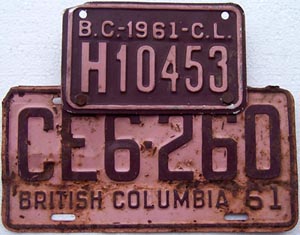 |
The image at left shows how the Motor Carrier plate would generally have been attached to a vehicle, and that the vehicle displaying such a plate would generally be registered as commercial. To read more about these underlying Commercial plates, Click Here. |
| 1962 - Colour Variation | |
 |
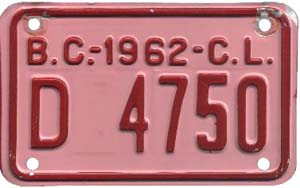 |
An interesting, but probably not very consequential colour variation can be discerned in some of the 1962 plates. The example at left is displaying the standard colours used on the passenger plates in 1961, while the example at right is displaying a slightly redder colour on the letters and numbers. |
|
*
* * * * |
During the licence-year 1968-69, an order amending Section 5.05 of the 5.32 of the Motor Carrier Act deleted the requirement for a letter to precede the numerals on the Carrier licence plate. As a result, the 1969 plates would not display a letter prefix. |
| 1969 | |||||||
|
|||||||
*
* * * * |
A rather busy plate with almost too much information on it was introduced in 1970. For whatever reason, the Public Utilities Commission was using the plates as a way to boost its profile and, as a result, the dies used for the serial are unduly small. |
| 1970 - 1973 | ||||||||||||||
|
||||||||||||||
*
* * * * |
In April of 1973, the newly elected NDP Government passed the Energy Act, certain provision of which provided for the constitution of an Energy Commission and abolition - on a date to be fixed by proclamation - of the Public Utilities Commission. |
At the same time, certain provisions of the Energy Act amended the Motor Carrier Act to provide for the establishment of a Motor Carrier Commission of not more than three (3) persons to perform the functions previously carried out by the Public Utilities Commission in relation to the Motor Carrier Act. These amendment also placed the Motor Carrier Act and its administrative machinery under the jurisdiction of the Minister of Transportation. |
The actual physical transition in the administration of the Motor Carrier Act took place in July 1974, with an earlier amendment to Regulation 5.32 concerning the information to be shown on motor carrier license plates being made to cover the transition of the administration of the Motor Carrier Act from the Public Utilities Commission to the Motor Carrier Commission. |
This amendment to Regulation 5.32 is considered to have resulted in the rather slap-happy change to the 1974 plates that saw the bottom quarter of the plate literally cut-off where, it is assumed, the words "Public Utilities Commission" had already been stamped. |
| 1974 - Abolition of Public Utilities Commission | |||||||
|
|||||||
| 1974 - High Number Variation | |
By the end of the 1974 series when the original allotment had been issued, regular sized plates on the 1975 base began to appear as over-run. |
|
*
* * * * |
| 1975 - 1981 | ||||||||||||||||||||
|
||||||||||||||||||||
*
* * * * |
| 1982 - 1984 | ||||||||||||
|
||||||||||||
*
* * * * |
| 1985 - 1987 | ||||||||||||
|
||||||||||||
| Expo 86 - Temporary Licenses |
Due to the anticipated influx of tourists to Vancouver throughout the summer of 1986, accomodation was made for the provision of temporary Motor Carrier licenses in order to ensure that there were enough taxis plying the streets of the City to move all the tourists to where they wanted to be. |
| Obscured Jurisdiction |
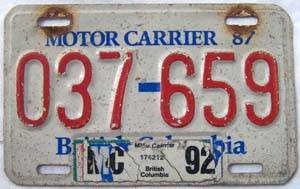 |
Probably in order to take advantage of economies of scale resulting from the province's introduction of the "Flag" design in 1985, the Motor Carrier Commission began utilising the same base type as that used on motorcycle and trailer plates. The basic design of the plate, however, would remain substantially unchanged from that which had been used in the period from 1982 to 1984. |
This design would prove problematic when the decision was made to finally start revalidating Motor Carrier plates with decals in the late-1980s. Although the plates would undergo a redesign for 1988, as can be seen on the plate above, the 1987 base would be renewed with placement of the decal effectively obscured issuing jurisdiction (i.e. "British Columbia"). |
*
* * * * |
|
In the early 1980s, Transport Canada conducted a lottery to determine which taxi companies would be authorized to operate at Vancouver International Airport. |
|
Winners of the lottery were then issued supplementary licence plates that allowed them to pick-up customers at the Airport. |
|
In 1992, the Vancouver Airport Authority assumed control of the Airport from Transport Canada, which resulted in the issuance of a redesigned plate to taxi cabs |
|
The following year, in response to numerous customer complaints regarding taxi drivers lack of local knowledge, refusal to take short trips, use of excessive speed, lack of English language skills, poor customer service skills, and over-charging, the Authority required drivers working at the Airport to take TaxiHost training and mandated that the vehicle be of a certain age. |
|
More recently, the Airport Authority has encouraged the use of alternative-fuel taxis, and requires drivers undertake training in helping people with special needs. Supplementary licence plates are no longer issued to taxi cabs operating at the Airport |
| Vancouver International Airport (YVR) License Plates | |||
NOTE: The "C" is a decal that has been placed over a "T" prefix and also covers the small decal box shown on the other two plates. It is assumed all three plates are from the 1990s but it is not known if the prefixes denote a type of vehicle. |
|||
*
* * * * |
| 1988 - 1994: Red Numbers | ||||||||||||||||||||
1988 |
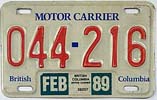 |
|
||||||||||||||||||
| 1995 - 2005: Blue Numbers | ||||||||||||||||||||||||||||
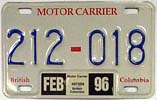 |
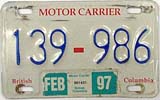 |
 |
|
|||||||||||||||||||||||||
2002 |
||||||||||||||||||||||||||||
2003 |
2004 |
2005 |
||||||||||||||||||||||||||
| 1994 - 2001: Taxi | ||||||||||||||||||||||
|
||||||||||||||||||||||
1998 |
||||||||||||||||||||||
| Motor Carrier Decals - 1988 - 2005 | ||
1988 |
1989 |
 |
 |
 |
 |
 |
 |
 |
 |
 |
 |
 |
 |
2002 |
2004 |
2005 |
|
Quick Links: |
Motor Carrier | Prefix Gallery | Classifications | Passenger Carrier |
Antique | APEC | BC Parks | Chauffeur Badges | Collector | Commercial Truck | Consul | Dealer | Decals | Driver's Licences | Farm | Ham Radio | Industrial Vehicle | Keytags | Lieutenant Governor | Logging | Manufacturer | Medical Doctor | Memorial Cross | Motive Fuel | Motor Carrier | Motorcycle | Movie Props | Municipal | National Defence | Off-Road Vehicle | Olympics | Passenger | Personalized | Prorated | Prototype | Public Works | Reciprocity | Repairer | Restricted | Sample | Special Agreement | Temporary Permits | Trailer | Transporter | Veteran | Miscellaneous |
© Copyright Christopher John
Garrish. All rights reserved.

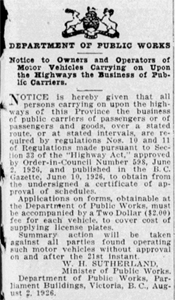
 According to press reports from January of 1927, the new license plates for the forthcoming year to be issued to operators of buses would be "white letters on an olive background" and would be issued by the Department of Public Works.
According to press reports from January of 1927, the new license plates for the forthcoming year to be issued to operators of buses would be "white letters on an olive background" and would be issued by the Department of Public Works.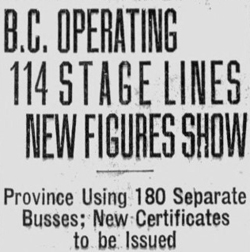 Almost 12 months later, it was being reported that approximately 180 "Special Permit" license plates had been issued to 114 different bus ("stage line") companies in 1927.
Almost 12 months later, it was being reported that approximately 180 "Special Permit" license plates had been issued to 114 different bus ("stage line") companies in 1927.

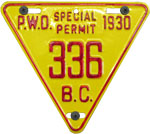
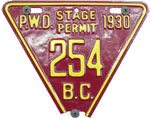
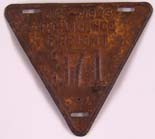


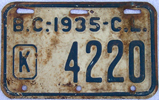

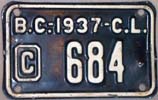


.jpg)


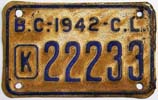



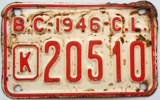

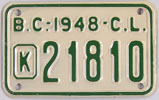
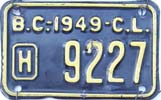


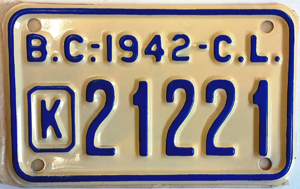
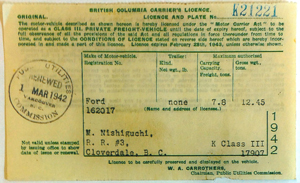
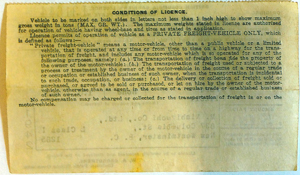
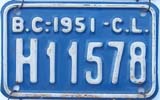



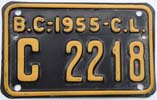
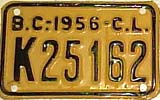

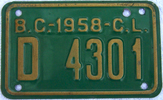
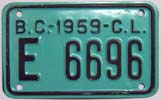



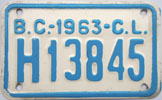
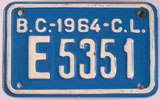
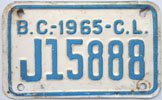
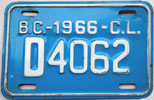
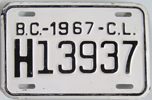

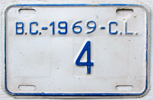
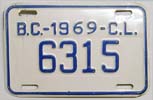


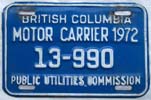
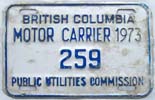

.jpg)
